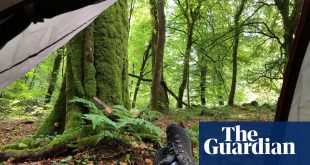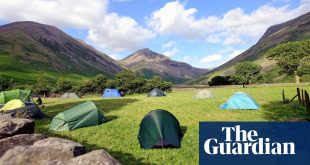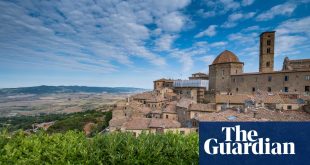The English language has spawned some cracking opening lines, from Jane Austen’s “a truth universally acknowledged” to Orwell’s “clocks striking thirteen”. And now another has been added to the canon: the opening gambit of an info board on Sweden’s Biosphere Trail. “Every village,” it declares, “was required by law to dig its own wolf trap.”
It was only our second day on the trail, but we’d already been so enchanted by the scenery – the placid lake, the bright welcoming woods, the picturesque rural cottages – that it came as no real surprise to find we’d stumbled into a fairytale.
Opened last summer, the 85-mile Biosphere Trail skirts the southern shores of Lake Vänern, Sweden’s largest and Europe’s third largest lake. The route is named after the Lake Vänern Archipelago Biosphere Reserve, designated by Unesco in 2010. I confess I’d not really come across biosphere reserves before but there are 738 of them worldwide, all promoting “solutions reconciling the conservation of biodiversity with its sustainable use”. There was certainly a good deal of conservation going on, for we seemed to be continually entering one nature reserve or other. And we’d arrived by train from the UK (a pleasant trundle through France, Belgium, Germany and Denmark), which we hoped would bolster the “sustainable use” bit.
We started our walk at Mariestad, the town that marks the trail’s eastern extremity. It possesses one of Sweden’s best-preserved historic districts, so we had a wander through streets of what looked like giant doll’s houses, all decked out in bright pastel shades. After a shufti round a cathedral with fossils embedded in its stone floor, we set off along the shore, armed with maps that the frequent waymarkers made all but redundant. Very soon we saw our first wildlife: a statuesque heron, a rather busier woodpecker, followed by kestrels, butterflies, deer and lapwings.

Lake Vänern is so large (about quarter the size of Wales) that where the trail runs along the shore it seems more like a coastal path – an impression reinforced by the appealing sandy coves we come across. We discovered that south-west Sweden can get quite warm in August, so by the time we reached our first night’s lodgings, we were somewhat parched. Äppelgården B&B is a perfectly preserved 19th-century farmhouse, full of pleasingly esoteric period antiques. It’s also far from the nearest off-licence so I asked co-owner Diedrich if we could buy some beer from him to accompany the meal we were about to cook in the kitchen. A few minutes later he was plying us with four bottles of a local brew for which he refused any payment. He replied to our protests with a wink and a laugh. “Don’t worry,” he said, “I’ve just stolen them from my son.”
So began five days of gentle rambling through woodland and farmland, meadows and hamlets. While the route is mostly rural, there was always a shop or cafe en route where we could buy lunch. And this being Sweden, everything was extremely clean and fresh and uncomplicated. The only major town we encountered was Lidköping, a town that found fame and fortune as a producer of porcelain, and where we ate dinner at Mellbygatans restaurant. The owner, Emil, told us that running the restaurant was “all about having fun”. It seems a successful strategy since in Mellbygatans’ first year it entered the prestigious White Guide with ratings on a par with some Michelin-starred restaurants.
Indeed, such was the quality of the food we ate along the way – often inexpensively – that we felt as if we were on a gastronomic tour as much as a nature-lovers’ hike. “We grew this ourselves,” was a phrase we became accustomed to as we sat down to a meal – from cherries and strawberries to broccoli and rhubarb.
At Hellekis Kök & Trädgårdscafé, in the delightful gardens of Hellekis Säteri, we ate a homegrown lunch and had the joy of dining beneath the shady boughs of a 120-year-old ginkgo tree. Aside from its offspring growing nearby, this was apparently “the only one for 200 miles”.
Later, at Trolmens B&B – “possibly Sweden’s first vegan B&B” according to its Norwegian co-owner Caroline – we tucked into one of the tastiest breakfasts I’ve had. It included sea buckthorn from Vãnern’s shoreline, a chia seed pudding and a vegan version of the classic Swedish topper skagenröra, with tofu and avocado supplanting the usual shrimp and roe.
So it was fitting that at the posh-hostel Lugnåsberget Ekohotell, we were able to furnish others with toothsome provender. “Strip a few small branches off the tree by the barn,” co-owner Jesper advised us, “and you can feed our pet sheep.” Cue two very appreciative ungulates.

Although we enjoyed our comfy accommodation en route, Sweden’s right-to-roam laws – Allemannsrätten – make wild camping on the Biosphere Trail a plausible budget option. You can pitch almost anywhere that’s not private land or a nature reserve – as long as you leave no trace.
And if, like us, you don’t have seven or eight days to walk the trail’s full 85 miles, help is at hand in the form of the Kinnekullebanan. Voted the nation’s prettiest railway line, its single track, bijou halts and tram-like trains made taking the odd ride along sections of the trail a real pleasure. Trolmen’s grassy platform and tiny library won our hearts, but it was Källby station that gave us our most memorable encounter. A railway employee ambled up to the platform and repeatedly tapped his phone on the underside of a bench. Our curiosity piqued, we asked him what he was doing. He looked at us for a moment and replied, “There’s too much electricity here.” Apparently, that can be a thing. At least in Sweden.
after newsletter promotion
Other less charged highlights of our walk included a rather endearing woodland museum in an old millstone quarry; the fishing village of Spiken where we flopped down on a greensward by the harbour and watched swifts darting about above our heads; and the baroque Läckö Castle, the western end of the Biosphere Trail, which sits high on a promontory overlooking the lake. We spent our final night in its shadow at Vänerskärgården Victoriahuset, a modern hotel designed to resemble the local trees and reeds. After dinner (yet more garden-grown veg), we sat by the lake and got some free jazz, courtesy of an open-air concert in the castle grounds, and watched the pink sky dissolve into darkness as geese flew south in giant V formations.
In the morning we went for a refreshing dip in the lake and discussed our surprise that we’d seen so few others walking the trail. It was certainly not for fear of wolves. Of which, I’ve some happy news for animal lovers – according to another info board we saw, “There is no evidence that any wolf trap ever caught a wolf.”
Rail tickets supplied by Interrail – Five days within one month global pass £260 (28+), £196 (12-27), free (4-11). Further info from West Sweden Tourist Board
 Top Naija News – Nigeria News, Nigerian News & Top Stories Top Naija News – Nigerian Newspapers, Nigerian News. topnaijanews is a daily Nigerian newspaper covering Latest News, Breaking News, Entertainment, Sports, Lifestyle and Politics.
Top Naija News – Nigeria News, Nigerian News & Top Stories Top Naija News – Nigerian Newspapers, Nigerian News. topnaijanews is a daily Nigerian newspaper covering Latest News, Breaking News, Entertainment, Sports, Lifestyle and Politics.



